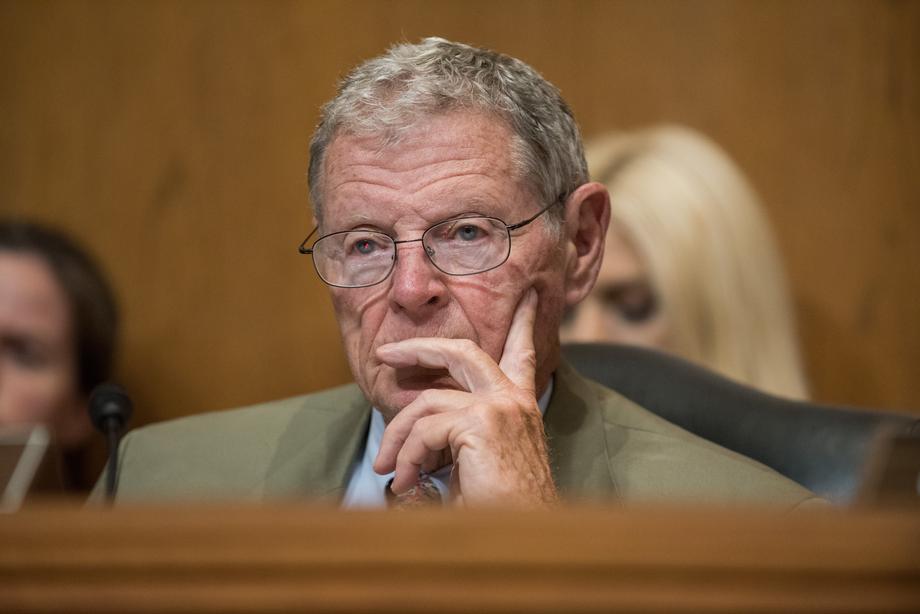
WASHINGTON — At the end of a roughly two-hour hearing that focused for only a few minutes on the Department of Energy’s $6.5-billion-a-year Cold War nuclear cleanup operation, no senator indicated any opposition to the White House’s pick to lead the program.
Anne Marie White “got off pretty easy,” Sen. James Inhofe (R-Okla.), acting chairman of the Senate Armed Services Committee, said moments before he adjourned a nomination hearing in which White testified alongside another Department of Energy nuclear nominee and the administration’s choice to lead the Pentagon’s unified Cyber Command.
Senators focused on the Cyber Command nominee, Army Lt. Gen. Paul Nakasone, for the vast bulk of the hearing. White got about 10 minutes of attention, including a five-minute opening statement.
President Donald Trump on Jan. 8 nominated White, a consultant with a master’s degree in nuclear engineering, to lead the Department of Energy’s Office of Environmental Management (EM). White has already been recommended for confirmation by the Senate Energy and Natural Resources Committee, which considered her nomination last month.
However, Sen. John Barrasso (R-Wyo.) has put a hold on White over objections to the agency’s uranium barter program, making it uncertain she will be confirmed by the full Senate if the Armed Services Committee approves her nomination. The committee had not scheduled a vote on White’s nomination at press time Friday for Weapons Complex Monitor. A Barrasso spokesperson did not immediately reply to a request for comment.
Despite the Armed Services Committee’s limited appetite for Energy discussion Thursday, White did draw questions from Ranking Member Jack Reed (D-R.I.) and Sen. Kirsten Gillibrand (D-N.Y.). Reed asked how White would accelerate cleanup at the Hanford Site in Washington state: EM’s largest, most expensive, most technically challenging Cold War environmental remediation.
“The Hanford Site is very complex,” White told Reed. “There’s numerous challenges there, from tank waste to some of the waste management issues. And one thing I’d like to consider when I’m looking at these problems is that there’s a very long timescale involved in all things nuclear, so we need to make sure we make decisions that are timely, they are technically underpinned and cost underpinned.”
Gillibrand, on the other hand, wanted White — if confirmed — to look into EM’s decision to approve around 150 truck shipments of nuclear waste from Canada through New York state to the department’s Savannah River Site in Aiken, S.C.
Gillibrand said she was concerned the Department of Energy had approved the shipments “based on data showing that trucking solid nuclear waste can be done safely. However, this waste is in liquid form [and] I am seriously concerned that the office of environmental management approved these transports, and I am concerned that the communities through which this waste may transit are not fully informed.”
“If confirmed, I will look into this issue get a better understanding of the pathway so far and the path forward, and keep you informed,” White told Gillibrand.
Notably, committee member Sen. Martin Heinrich (D-N.M.) did not question White during the hearing. The junior senator from the Land of Enchantment is a vocal guardian of the Waste Isolation Pilot Plant (WIPP) near Carlsbad, N.M., in the southeast corner of the state. The EM-operated salt mine is the nation’s only permanent, deep-underground disposal site for radioactively contaminated material and equipment known as transuranic waste.
WIPP reopened last year after a nearly three-year closure sparked by an exploding barrel of transuranic waste that leaked radiation into the underground. The leak was blamed on an improperly packaged waste barrel from the Los Alamos National Laboratory in northern New Mexico.
White also answered about 40 queries in a packet of advance policy questions the committee released Thursday. In the packet, White took a shot at EM contractors.
“Clearly a major challenge has been contractor performance in the areas of completing projects on time and within budget,” White wrote. “This has been especially the case for new facility construction and start up.”
White also pledged to examine whether sites are spending their annual appropriations efficiently.
“If confirmed, I will address funding challenges through a review of the EM site budgets to ensure the funding Congress has allocated is being appropriately applied to the cleanup mission,” White wrote in reply to lawmakers’ advance policy questions. “The completion and closure mindset that was present earlier in the EM program needs to be re-energized.”
Meanwhile, while Inhofe’s unscripted quip at the end of the hearing — that White got off lightly as members directed the spotlight elsewhere — drew a laugh from the room’s small audience, his prepared remarks at the beginning of the hearing painted a more serious picture of what awaits White at EM headquarters in Washington, D.C.
“The environmental office at DOE has been plagued with projected management issues, safety concerns, and continuous technical challenges,” Inhofe told White. “You’ve got your work cut out for you there.”